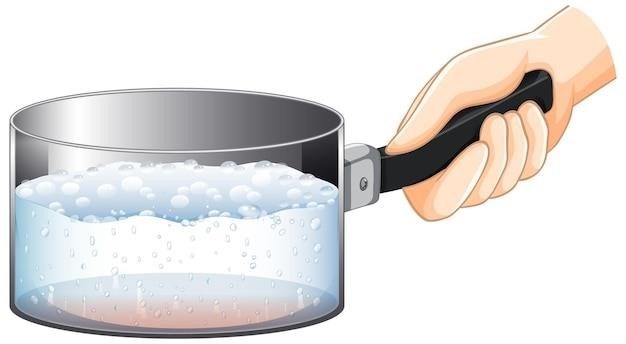What Temperature Should the Water Be for Manual Dishwashing?
While many believe that hot water is essential for clean dishes, the truth is that the temperature of the water isn’t as crucial as you might think. For handwashing, the ideal water temperature is warm, not scalding hot. Research has shown that even cool water can effectively remove bacteria from dishes when combined with proper scrubbing and dish soap.
The Importance of Water Temperature
While many believe that hot water is essential for clean dishes, the truth is that the temperature of the water isn’t as crucial as you might think. Research suggests that the temperature of the water used for handwashing dishes doesn’t significantly impact the removal of bacteria. The key to achieving clean dishes lies in proper scrubbing and the use of effective dish soap.
However, there are a few reasons why warm water is still preferred for handwashing. Warm water helps to loosen food particles and grease, making them easier to remove with soap. It also helps to dissolve dish soap, making it more effective. Additionally, warm water can help to prevent the buildup of soap residue on dishes.
It is important to note that excessively hot water can be harmful. Prolonged exposure to hot water can scald your skin, causing irritation and damage. It is also important to use water that is comfortable for your hands, as this will help to prevent injury.
Ideal Temperature Range
While the ideal temperature for handwashing dishes isn’t as critical as many believe, there is a range that is generally considered most effective. For optimal cleaning, the water temperature should be warm enough to help loosen food particles and grease, but not so hot that it scalds your hands.
A comfortable range for handwashing dishes is between 104 to 131 degrees Fahrenheit. This temperature range is warm enough to effectively dissolve dish soap and loosen food particles, yet cool enough to avoid burning your hands. However, it’s important to remember that even within this range, personal preference plays a role.
Some people may find that water at the lower end of this range is sufficient for their needs, while others may prefer a slightly higher temperature. Ultimately, the best temperature for you will depend on your individual comfort level and the specific dishes you are washing.
Remember, the key is to use water that is warm enough to be effective, but not so hot that it causes discomfort or injury.
Factors Influencing Temperature Choice
While the ideal temperature for handwashing dishes falls within a certain range, several factors can influence your choice. These factors include⁚
- Type of dish⁚ Dishes with heavy grease or baked-on food may require slightly hotter water to effectively loosen and remove the residue. However, delicate dishes or those with intricate designs might be better suited to cooler water to prevent damage.
- Dishwashing detergent⁚ Different dish detergents have different temperature requirements for optimal effectiveness. Some detergents work best in warm water, while others are designed for cold water. Always check the label of your dishwashing detergent for specific temperature recommendations.
- Personal preference⁚ Ultimately, your comfort level plays a significant role. Some people prefer to wash their dishes in very hot water, while others find it more comfortable to use cooler water. The choice is entirely yours, as long as the water is warm enough to effectively clean your dishes.
It’s important to find a balance between effective cleaning and personal comfort. Remember, the temperature of the water isn’t the only factor that determines the cleanliness of your dishes.
Safety Considerations
While hot water can be effective for cleaning dishes, it’s essential to prioritize safety when handwashing. Excessively hot water can cause severe burns, especially for children and individuals with sensitive skin. Here are some safety considerations to keep in mind⁚
- Temperature limits⁚ Avoid using water temperatures above 120 degrees Fahrenheit, as this can be dangerously hot. The FDA recommends a wash solution temperature of 110 degrees Fahrenheit for commercial dishwashing, but this is still too hot for prolonged hand contact.
- Test the water⁚ Always test the water temperature with your elbow or the back of your hand before immersing your hands. If it feels too hot, adjust the temperature accordingly.
- Avoid direct contact⁚ Minimize direct hand contact with hot water, especially when rinsing dishes. You can use a sponge or a dish brush to help protect your hands.
- Supervision for children⁚ Always supervise children when they are around hot water, and teach them about the dangers of burns.
Safety should always be your top priority when handwashing dishes. By taking precautions, you can ensure a safe and enjoyable dishwashing experience.
Temperature for Commercial Dishwashing
Commercial dishwashing practices differ significantly from home handwashing, primarily due to the higher volume of dishes and the need for stricter hygiene standards. The Food and Drug Administration (FDA) sets specific temperature requirements for commercial dishwashing to ensure proper sanitization and prevent foodborne illnesses.

The FDA mandates a wash solution temperature of at least 110 degrees Fahrenheit for handwashing dishes in commercial food establishments. This temperature is crucial for effectively removing food particles and bacteria. However, it’s important to note that this temperature is too hot for prolonged hand contact and is typically achieved using specialized commercial dishwashing equipment.
In addition to the wash solution temperature, commercial dishwashing also involves a rinse cycle with water heated to even higher temperatures, often reaching up to 180 degrees Fahrenheit. This high heat helps to ensure that dishes are thoroughly sanitized and free of any remaining food particles or bacteria. The combination of the wash and rinse cycles ensures that dishes are properly cleaned and safe for use in food service.
The Role of Dishwashing Detergent
Dishwashing detergent plays a crucial role in achieving clean dishes, regardless of the water temperature used. It acts as a surfactant, a substance that reduces surface tension between liquids and solids, allowing it to break down grease, food particles, and other debris that cling to dishes. Detergent molecules have a unique structure with a hydrophilic (water-loving) head and a hydrophobic (water-repelling) tail.

The hydrophilic head attracts water molecules, while the hydrophobic tail attaches to grease and oil molecules. This allows the detergent to encapsulate grease and lift it away from the dishes. The detergent also helps to loosen and lift away food particles, making them easier to rinse away with water. The effectiveness of dishwashing detergent can vary depending on the type and quality of the product. Some detergents are specifically designed for use in hot water, while others are formulated for cold water.
While hot water can help to activate the detergent and enhance its cleaning power, it’s not essential for effective dishwashing. Many modern detergents work effectively in both hot and cold water, so the choice of water temperature ultimately comes down to personal preference. The key is to select a detergent that is appropriate for the type of dishes being washed and the water temperature being used.
Alternatives to Hot Water
While hot water is often associated with clean dishes, there are alternatives that can effectively remove food particles and germs without relying on high temperatures. One such option is using a dishwasher. Dishwashers are designed to effectively clean dishes using a combination of hot water, detergent, and mechanical action. They can achieve higher temperatures than what is comfortable for handwashing, ensuring a more thorough cleaning.
Another alternative is using a cold-water detergent specifically formulated for cold-water washing. These detergents contain enzymes that break down food particles and grease at lower temperatures. Additionally, using a good quality dish scraper can help to remove food scraps before washing, reducing the amount of cleaning required. Pre-washing dishes with cold water before using a dishwasher can also contribute to a cleaner result, especially for heavily soiled items.
While hot water may seem like a necessity for clean dishes, it’s important to remember that it’s not the only solution. Alternatives like dishwashers, cold-water detergents, and pre-washing techniques can provide effective cleaning results while saving energy and protecting your hands from scalding.
The Myth of Hot Water for Germs
The common belief that hot water is necessary to kill germs on dishes is a myth. While high temperatures can indeed kill some bacteria, the water temperatures typically used for handwashing are not hot enough to effectively eliminate all pathogens. In fact, the Food and Drug Administration (FDA) specifies a wash solution temperature of 110 degrees Fahrenheit for dishwashing by hand in commercial food establishments, which is too hot for hands but not hot enough to kill most germs.
Research has shown that even cool water can be effective at removing bacteria from dishes, as long as proper scrubbing and dish soap are used. The key to removing germs is not just the temperature of the water, but the physical removal of food particles and bacteria through scrubbing. Soaking dishes in soapy water can also help to loosen food debris and make them easier to clean.
Furthermore, the prolonged exposure to hot water can actually be harmful to your hands, leading to dryness, irritation, and damage to the protective layer of the skin. This can make your hands more susceptible to bacterial infections. Therefore, relying on hot water for germ elimination is unnecessary and potentially detrimental. Instead, focus on using a good dish soap and scrubbing thoroughly to ensure the removal of food particles and bacteria.
The Importance of Scrubbing
While water temperature plays a role in dishwashing, it’s not the primary factor in removing germs and ensuring clean dishes. The most crucial aspect is the physical act of scrubbing. Thorough scrubbing with a sponge, brush, or dishcloth is essential for removing food particles, bacteria, and any other contaminants from the surface of dishes.
The combination of mechanical action and dish soap effectively dislodges and lifts away dirt, grime, and microbes. This process is far more important than relying solely on hot water for sanitization. Even if the water temperature is high, it won’t reach every nook and cranny of your dishes, especially those with intricate designs or tight spaces.
Furthermore, some studies have shown that even cool water can be effective at removing bacteria from dishes when combined with proper scrubbing. So, instead of focusing on the temperature of the water, prioritize the scrubbing process. Make sure to scrub every surface of your dishes thoroughly, using a good quality dish soap. This will ensure that your dishes are clean, sanitized, and safe for use.
In conclusion, while hot water can be beneficial in dishwashing, it’s not a necessity for clean and sanitized dishes. The temperature of the water is less important than thorough scrubbing with a sponge, brush, or cloth, combined with a good quality dish soap. The mechanical action of scrubbing effectively removes food particles, bacteria, and other contaminants.
Focus on using warm water that is comfortable for your hands and prioritize the scrubbing process. Ensure that you reach every surface of your dishes, especially those with intricate designs or tight spaces. By following these simple steps, you can effectively clean and sanitize your dishes without relying solely on hot water.
Remember, clean dishes are not just about aesthetics; they are about ensuring the safety and hygiene of your food preparation. By combining proper scrubbing with appropriate dishwashing detergent, you can ensure that your dishes are clean, sanitized, and safe for use, regardless of the water temperature.


